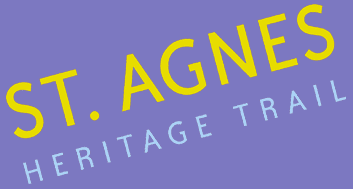
Walk 7 - Wheal Coates, Chapel Porth, Wheal Lawrence Valley and Goonvrea
Follow the path through the willow bushes and at a crossroads in the paths, turn left through the 'kissing gate'. Cross the stream, and a concrete bridge over a smaller spring. Turn right and follow the track along the Wheal Lawrence valley, ignoring a turning to the left by an open gate, where the track again crosses the stream. In recent years oak, beech, larch and other young trees have been planted in this area.
On the left by the stream, a copse of small elms
has grown again after larger specimens
succumbed to Dutch elm disease. On the right,
there are the heaps and shafts of further mineworkings.
A bend in the valley provides shelter
from the prevailing winds, and on the left, a
cottage with early-flowering camellias,
magnolias and azaleas fits snugly into the
hillside.  The trees in the garden provide homes for many birds, including jays, long-tailed tits and goldcrests. In spring, the lush vegetation in the valley
J encourages migrant birds such as chiff chaffs, black caps and, less frequently now, willow warblers. In sunny
weather, dragon and damsel flies appear, and speckled wood butterflies are resident. 150 metres from the
cottage the track passes, on the right, a pipe from
The trees in the garden provide homes for many birds, including jays, long-tailed tits and goldcrests. In spring, the lush vegetation in the valley
J encourages migrant birds such as chiff chaffs, black caps and, less frequently now, willow warblers. In sunny
weather, dragon and damsel flies appear, and speckled wood butterflies are resident. 150 metres from the
cottage the track passes, on the right, a pipe from  which water flows all the year round K. This spring and the
stream it joins must have been used for thousands of years by local people. Flint scrapers and flakes dating
from 5,000 BC have been found in the field behind the water-chute.
which water flows all the year round K. This spring and the
stream it joins must have been used for thousands of years by local people. Flint scrapers and flakes dating
from 5,000 BC have been found in the field behind the water-chute.
 A few metres beyond the spring, turn left, (stepping over a little stream if it's wintertime!) into a narrow
lane L and follow this up the side of the slope, listening for the buzzard which nests in the nearby pine
trees. Part of this lane probably follows the line of the ancient Bolster Bank or Dyke as it runs towards Chapel
Porth. At the top end, it emerges by houses on to a wider lane. Turn left up a steep slope. Head straight
across the Chapel Porth road, following a footpath sign which says 'Public Bridleway'. Turn left when
you reach another road, Beacon Drive, and follow it for a kilometre, looking out (between July and March)
for curlews in the neighbouring fields. You will then find yourself back at Wheal Coates car park.
A few metres beyond the spring, turn left, (stepping over a little stream if it's wintertime!) into a narrow
lane L and follow this up the side of the slope, listening for the buzzard which nests in the nearby pine
trees. Part of this lane probably follows the line of the ancient Bolster Bank or Dyke as it runs towards Chapel
Porth. At the top end, it emerges by houses on to a wider lane. Turn left up a steep slope. Head straight
across the Chapel Porth road, following a footpath sign which says 'Public Bridleway'. Turn left when
you reach another road, Beacon Drive, and follow it for a kilometre, looking out (between July and March)
for curlews in the neighbouring fields. You will then find yourself back at Wheal Coates car park.
 Walk 1 - St.Agnes Village Trail
Walk 1 - St.Agnes Village Trail Walk 2 - St Agnes Beacon
Walk 2 - St Agnes Beacon Walk 3 - Porthtowan, Banns Vale, Mount Hawke and Chapel Porth
Walk 3 - Porthtowan, Banns Vale, Mount Hawke and Chapel Porth Walk 4 - Wheal Rose, The Poldice Plateway and Mawla
Walk 4 - Wheal Rose, The Poldice Plateway and Mawla Walk 5 - Mount Hawke
Walk 5 - Mount Hawke Walk 6 - Mithian
Walk 6 - Mithian Walk 7 - Wheal Coates, Chapel Porth, Wheal Lawrence Valley and Goonvrea
Walk 7 - Wheal Coates, Chapel Porth, Wheal Lawrence Valley and Goonvrea Walk 8 - Water Lane, Wheal Butson and Jericho Valley
Walk 8 - Water Lane, Wheal Butson and Jericho Valley Walk 9 - Jericho Valley and Cross Coombe
Walk 9 - Jericho Valley and Cross Coombe Walk 10 - Blackwater
Walk 10 - Blackwater
